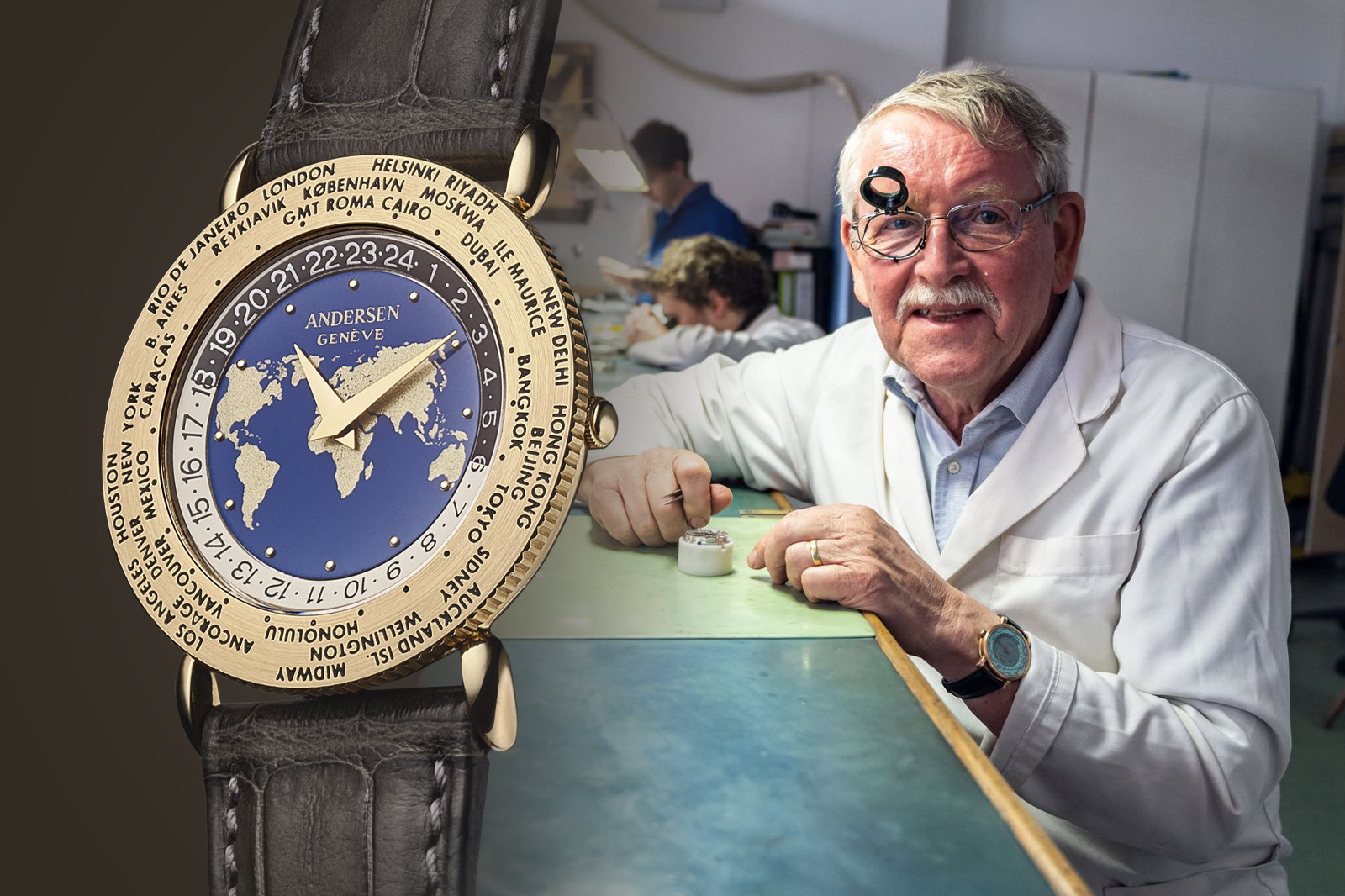


Watchmaking and Geneva, you simply cannot have one without the other. As a city, it carries its horological legacy on its sleeve. Turn the cobblestone corners of the Old Town and Urwerk’s HQ is nestled on the Place du Bourg-de-Four, just down the road from AkriviA. Look up when meandering around Plainpalais, and you’ll stumble upon the world-famous Patek Philippe Museum. Leave the Mandarin Oriental, and you’ll be a stone’s throw away from Andersen Genève’s home. This city bleeds watchmaking, and for Svend Andersen, it’s where he founded his eponymous manufacture in 1980.
While many know the brand’s watches today for their mastery of complications paired with traditionally coded, yet unique executions born out of a labour of love, when Svend’s independent journey began, international collectors wanted him to make one watch: a world timer.

Svend Andersen
40 years ago, the concept of an ‘independent watchmaker’ of any notable significance was in its infancy, practically unheard of. As an industry, watchmaking was still actively licking its wounds caused by the disruptive arrival of battery-powered watches. At scale, the luxury Swiss watch industry was transforming, shifting from being the zeitgeist to flirting with being on the brink of relevance. That was until the concept of luxury was modernised with steel watches and bold new sporty references. This evolution appealed to a new generation, resulting in the maturing of watch collecting in the 1990s.
At the even higher, more nuanced end of the spectrum, talented watchmakers behind many legacy brands’ successes took their talent under a new roof: one with their name above the door. Think Daniel Roth, F.P. Journe, Franck Muller, and Svend Andersen.

A tribute to Louis Cottier, 24 18k yellow gold Communication world timers were originally produced in 1989
Called the Communication, Svend’s first watch was sold in 1989 by subscription to existing Italian and German clients of Svend’s pocket watch case-making operation. With only 24 examples, the watch is an 18k yellow gold world timer and a tribute to Louis Cottier, the father of the world timer, a complication Svend spent a lot of time working on while at Patek Philippe.
Upon selling all 24 models, to meet the number of requests, Andersen Genève produced approximately 50 to 100 more examples of the Communication but now with teardrop lugs, paying homage to the Patek 1415 – yet another watch Svend was familiar with during his Patek tenure. Both Communication edition cases are beautifully crafted, and there’s a very good reason for that: they were produced by legendary case maker Jean-Pierre Hagmann, with Andersen being Hagmann’s first-ever client.


Christopher Columbus with Chinese lacquered dial displaying the Atlantic Ocean with the route of Columbus’ first voyage in 1492
This initiated a run of more world timers, with 500 examples of a piece created in 1992 to celebrate the anniversary of Christopher Columbus’s voyage. To underscore how talented Svend is, the Mundus World Time of 1994 achieved the world record as the thinnest world time watch ever produced thanks to the world time module he developed – a record it still holds today at 4.2mm.
Svend’s story could fill this issue with a grand legacy in watchmaking over the decades. Having been born in Denmark in 1942, working at Patek for nearly 10 years, and going on to launch not only one of the first independent watchmakers but still one of the most desirable, his life has been dedicated to this craft.

Adersen Genève Mundus World Time
He first made headlines in 1969 at the age of 27 debuting a side project called The Bottle Clock. This saw him place a working clock within a bottle despite the opening only being 18mm in width. An achievement that blew minds, it took five months to complete and earned him the moniker of Watchmaker of the Impossible, spotlighting his watchmaking.
Models have been offered for sale, with at most 124 ever being produced, the Christopher Columbus is more regularly seen. Having first-hand experience in repairing and assembling the last of the Louis Cottier modules Patek had in stock, the influences are apparent from the case, dial proportions, hands, and module architecture.
35mm in yellow gold, pink gold, or platinum, the watch carries a Chinese lacquered dial displaying the Atlantic Ocean with the route of Columbus’ first voyage in 1492. The calibre powering these pieces is the automatic Piguet 951, but it’s fitted with the complete bespoke world time module developed by Svend. This module measures just 0.9mm thick; including the dial.

Andersen Genève x Asprey Worldtime
Andersen Genève today bridges that gap between traditionality and proprietary styling that makes them simply irresistible. Which is why models like the Christopher Columbus stand out further with extremely classic styling. Compared to the 38mm cases they produce today, the mid-sized Christopher Columbus feels charmingly unassuming.
And in 2025, on the 45th anniversary of the original Communication, it’s fair to say these early world timers are just as relevant and appealing today.
Between leaving Patek, making pocket watch cases, and beginning his own manufacture, in 1985 Svend also found time to establish a community for independent watchmakers. The AHCI focuses on preserving tradition where it deems those working independently as the ‘guardians of these traditions’ in the face of the growing big brands and conglomerates.
Over the years, membership has been extended to the likes of George Daniels, Kari Voutilainen, F.P. Journe, Philippe Dufour, Raúl Pagès, Vianney Halter, Felix Baumgartner, and Andreas Strehler.
Andersen Genève’s output continues to be very limited and bespoke – for context, only 1,300 Andersen watches have ever been made.
More details at Andersen Genève.
Oracle Time